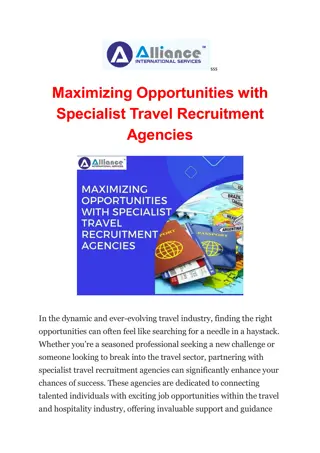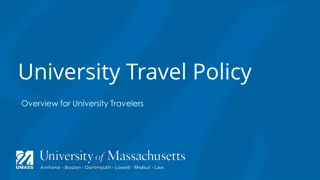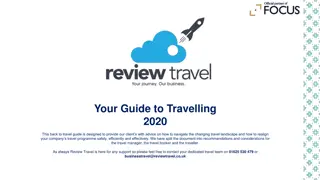Insights on Travel Trends in 2021 and Beyond
The travel industry faced challenges in 2021, with North American cruise passenger volumes decreasing significantly. Affluent Americans are ready to travel internationally in 2023, with preferences for Europe, the South Pacific, the Caribbean, and Canada. Cruise lines are adapting to post-pandemic concerns, focusing on guest health and sustainability.
Download Presentation

Please find below an Image/Link to download the presentation.
The content on the website is provided AS IS for your information and personal use only. It may not be sold, licensed, or shared on other websites without obtaining consent from the author.If you encounter any issues during the download, it is possible that the publisher has removed the file from their server.
You are allowed to download the files provided on this website for personal or commercial use, subject to the condition that they are used lawfully. All files are the property of their respective owners.
The content on the website is provided AS IS for your information and personal use only. It may not be sold, licensed, or shared on other websites without obtaining consent from the author.
E N D
Presentation Transcript
2021 Was Another Year of Struggles 2020 North American cruise passenger volume decreased by 80.8% from 2019, but 2021 s volume decreased by 84.7% from 2019. The average cruise duration of North American passengers was 6.4 days during 2021, compared to 6.9 days during 2019. The average age of North American passengers during 2021 was 49.1, compared to 45.7 for 2019, indicating older North Americans, more of whom had received multiple vaccinations, felt a cruise was safer than younger North Americans. With many Americans concerned about the COVID-19 Delta variant, 1.66 million of the total 2021 US passenger volume of 2.17 million sailed to the Caribbean, Bahamas and Bermuda; 209,400 to the North American West coast and Mexico; and 119,100 to Alaska.
Up Anchors for 2022 and Beyond Cruise Lines International Association (CLIA) forecasted its global cruise passenger volume index for 2022 will reach 95 (with 2019 volume as the baseline of 100). 2023 s projected index of 108 will exceed 2019. During 2021 and into early 2022, most cruise lines had to offer substantial discounts to lure passengers back to ships. As those discounts have had their desired effect, industry analysts expect Q4 2022 fares to increase by mid-single digits and exceed 2019 fares. The CLIA reports approximately 60% of cruise-related businesses and organizations are hiring as 272 ships were expected to sail during 2022, including 16 new ships, with an average passenger capacity of 2,126.
Americans Are Ready to Travel the World Results from the survey for the 2022 Portrait of American International Travelers report conducted by MMGY Travel Intelligence revealed affluent Americans will account for the largest increase in international travel during 2023. Although affluent Millennials said they were planning more average international trips during 2023 than Baby Boomers or 5.7 and 1.5, respectively, affluent Baby Boomers average spending for those trips will be $7,725, compared to $3,564 for Millennials. The survey respondents said their favorite international destinations will be Europe, the South Pacific, the Caribbean and Canada. They also preferred less-visited destinations and those with many outdoor recreational options.
More American Travel Insights Morning Consult s The State of Travel & Hospitality report also indicates most international travelers during the next year will be affluent. Of those with incomes of $100K, 17% said they had money saved for their trips, compared to all US adults at 14%. Higher-income US adults are also somewhat or very comfortable traveling as any COVID concerns have declined substantially: 79% of those who have traveled for leisure during the past year, 77% with incomes of $100K+ and 75% of those with incomes of $50K $99K. Another Morning Consult report, Are We There Yet?, stated 6% of all US adults said they took 1 or 2 cruises during the past year, but 9% of parents with children younger than 18 had taken 1 or 2 cruises during the past year with their children.
Addressing Guests Health and Sustainability Cruise lines became experts at developing and managing COVID-19 protocols. Despite almost two-thirds of cruise travelers being unconcerned about taking a cruise, cruise lines continue to offer testing, contactless technology and other sanitation methods. To achieve net carbon neutrality by 2050, cruise lines that are CLIA members are committed to advanced recycling protocols, waste-to-energy initiatives, energy-efficient ship design and the use of alternative fuels. According to the CLIA, there will be 26 LNG-powered cruise ships, 231 cruise ships with advanced wastewater treatment systems, 174 cruise ships with shoreside power connectivity and 176 cruise ships with exhaust gas cleaning systems by 2027.
Cruise Line News Many cruise line executives report their 2023 and future cruise bookings are almost full. A recent survey found land-based vacations can cost $1,500 to $6,400 more than an equivalent cruise, which is another cause of increased bookings. Norwegian Cruise Line Holdings expect 100% occupancy in most of its ships by summer 2023. Royal Caribbean Group achieved 96% occupancy during Q3 2022 and anticipates historical occupancy levels by spring 2023. Disney Cruise Line reports five ships will be sailing the Caribbean, Bahamas and the East and West coasts of the US. Disney recently acquired the former Global Dreamer, which will be redesigned and launched during 2025, and Disney Treasure will launch during 2024.
Advertising Strategies Now is the time for any business with a stake in the cruise industry to increase their ad spending as more people think cruising is safe, bookings on many ships are reaching 100% capacity and discounts are coming to an end. Older adults are still the primary cruise guest, making it relatively easy for travel and cruise companies to reach them on TV and with direct mail. Many of the prime cruise audiences are interested in new destinations and those with an emphasis on health and wellness. OTT and AVOD streaming services in conjunction with direct mail may be a good media mix to reach Millennials, and especially those with children, as more of them will be interested in family cruise vacations during the coming years.
New Media Strategies Cruise lines can repair their brand images with regular social media posts that explain their continuation of cleaning and safety procedures and the introduction of new ships being built to reduce effects on the environment and promote sustainability. Social media is also an effective platform to promote less-visited destinations and those with more outdoor recreational options that are and will continue to attract affluent Americans. Although most Gen Zers don t have the income to be regular or prime cruise guests, social media campaigns promoting discounts and more affordable three-day cruises can attract this age group and build brand recognition as they age.























